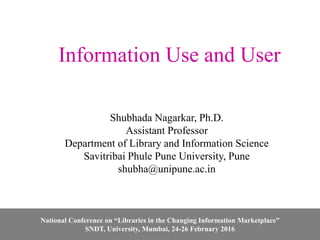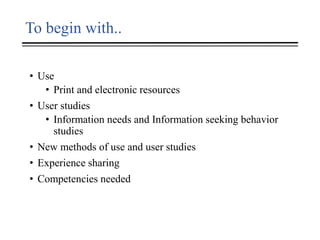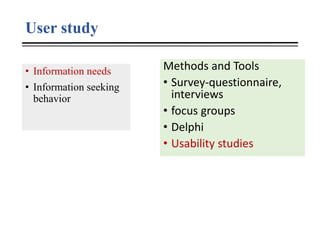Use and user study
- 1. Information Use and User Shubhada Nagarkar, Ph.D. Assistant Professor Department of Library and Information Science Savitribai Phule Pune University, Pune shubha@unipune.ac.in National Conference on âLibraries in the Changing Information Marketplaceâ SNDT, University, Mumbai, 24-26 February 2016
- 2. To begin with.. âĒ Use âĒ Print and electronic resources âĒ User studies âĒ Information needs and Information seeking behavior studies âĒ New methods of use and user studies âĒ Experience sharing âĒ Competencies needed
- 3. LIS Professional Knowledge of readers Knowledge of recorded information Knowledge of methods of brining records and readers together Selection Acquisition Organization Interpretation Evaluation of results Ref.: Shera, J.H. (1972) Foundations of Education for Librarianship, New York, Baker and Hayes, Inc. p 206. Role of LIS professional
- 6. Use studies
- 7. Use study Collection âĒ Print â books, journals and non book material âĒ E-resources âĒ E-journals, E-books âĒ Digital Libraries âĒ Institutional repositories âĒ Open Access resourcs âĒ e-books
- 8. Methods â usage of print collection âĒ Collection based analysis âĒ Mining and analysis of issue records âĒ Library Analytics, LMS reports âĒ Surveys âĒ Citation analysis
- 9. Issue record of LIBSYS
- 10. Analysis
- 11. Measuring the use of E-resources Methods âĒ Usage statistics by publishers, aggregators and consortia âĒ Citation analysis, i.e. application of quantitative techniques âĒ Conduct surveys Benefits âĒ To benchmark the needs âĒ To utilize the grants properly âĒ Journal wise usage âĒ To fill the gaps in subscriptions âĒ Add new relevant journals
- 14. Counting Online Usage of Networked Electronic Resources (COUNTER) âĒ Launched in March 2002, COUNTER (Counting Online Usage of Networked Electronic Resources) is an international initiative serving librarians, publishers and intermediaries by setting standards that facilitate the recording and reporting of online usage statistics in a consistent, credible and compatible way. âĒ SUSHI - Standardized Usage Statistics Harvesting Initiative (SUSHI) Protocol (ANSI/NISO Z39.93-2014) âĒ Defines automated request and response model for harvesting e-resource usage data âĒ Designed to work with COUNTER, the most frequently retrieved usage reports http://www.projectcounter.org/usage_factor.html http://www.niso.org/workrooms/sushi
- 16. Limitations of usage statistics âĒ Constantly changing resources and technology âĒ eBooks still need some work âĒ Limited picture of what users are actually doing Need to know âĒ Queries or Searches âĒ Page Views or Record Views âĒ Non vendor data â google analytics
- 17. How to increase usage? for librarians.. âĒ Do not accept mediocrity from vendors. âĒ Be willing to educate yourself on and participate in NISO Project COUNTER, and open source initiatives âĒ Conducting usability studies would help to understand the problems in searching information âĒ Information literacy programs about the use of e-resources, writing effective search strategies, etc. would help to a great extent âĒ Marketing of subscribed e-resources
- 18. Marketing and Evaluation âĒ Marketing Plan âĒ Understanding library users âĒ Creating the message âĒ Spreading the word âĒ Evaluation http://www.slideshare.net/houeidakam/marketing-eresources-adequate- tools-to-increase-usage Evaluation âĒ Gather feedback âĒ Ensure you are reaching the intended audience âĒ Analyze your usage statistics (compare multi- years)
- 19. Library web sites âĒ Revamp the webpage if needed âĒ Make your e-resources page attractive âĒ Use your library homepage to advertise âĒ Use of social media for marketing âĒ Attractive flyers with relevant information and instructions about the use of e-resources âĒ e-Resources Visibility, Website Trainings âĒ LibGuides Library Events Discovery Tool âĒ Library portals with links to e-resources http://www.slideshare.net/houeidakam/marketing-eresources-adequate-tools-to- increase-usage
- 20. User awareness OR Information Literacy Programs âĒ How to use electronic resources? âĒ Which e-resources are subscribed? âĒ How to search them effectively? âĒ Facilities provided by publishers and database vendors âĒ How to use e-resources on mobile devises or through smart phones
- 21. Questions to consider âĒ What are your goals for collection assessment? âĒ How do you evaluate e-resources at your library? âĒ Do you know whom to contact for usage data? âĒ When is a good time of year to evaluate e-resources? âĒ What is your process for cancellation/renewal? âĒ Do you have a collections committee? http://scholarworks.gsu.edu/cgi/viewcontent.cgi?article=1020&context=southeasternlac
- 22. User study
- 23. User study âĒ Information needs âĒ Information seeking behavior Methods and Tools âĒ Survey-questionnaire, interviews âĒ focus groups âĒ Delphi âĒ Usability studies
- 24. Information need and Information Seeking Behaviour âĒ An information need is a recognition that your knowledge is inadequate to satisfy a goal that you have âĒ Information seeking is a conscious effort to acquire information in response to a need or gap in your knowledge
- 25. Information needs and information seeking behavior studies Study user information needs by various ways âĒ Survey âĒ Working as a team member is user groups â embedded librarian âĒ Study user preferences in selection of information resources âĒ Study theoretical models of Information needs and ISB âĒ Conduct Usability studies of Library websites, OPACs, portals, specific databases
- 26. Cluster Mycology Biotechnology/ Biochemistry Farmer Characteristics of fungus P Biological observations / field observations P Geographical information P P Host Parasite Interaction Information P P Biochemical changes P Molecular Sequence information P Classification of fungus P P Economic importance of fungi P P P Fungicide Information P Bibliographic references P P Links to other database entries P P User groups and their information requirements
- 27. Usability testing Usability testing of library web sites and OPACs helps âĒ âuser-friendlinessâ of the system âĒ To identify difficulties faced by the users in locating the library information including materials, services, timings etc. âĒ in eliminating these problems with some changes in the interface design.
- 29. Methods of usability testing âĒ Card Sorting âĒ Contextual Interviews âĒ Focus Groups âĒ Heuristic Evaluation âĒ Individual Interviews âĒ Task Analysis âĒ Writing for the Web âĒ Parallel Design âĒ Personas âĒ Prototyping âĒ Surveys (Online)
- 30. Temasek Polytechnic Library, Singapore, Changes in User Interfaces
- 32. Competencies needed Core subject knowledge âĒ Be familiar with latest trends in the fields by participating in training programmes / conferences and seminars âĒ Participate in awareness workshops other than library and information science fields to understand the trends in research âĒ Awareness of latest trends in publishing âĒ Awareness of copyright and intellectual property laws Information organization skills âĒ Classification and cataloguing of library collection âĒ Use of control vocabulary tools like MeSH and other thesaurus âĒ Development and design of library portals
- 33. Competencies.. Computing skills âĒ Tools for library automation, digital libraries and content management, data and text mining âĒ Mobile and cloud based information services âĒ Skills of effective use of various search engines Collaborative skills âĒ In-depth knowledge of research and development programmes in the organization âĒ Collaborative activities with other faculty on the campus or within the organisation âĒ Work like embedded librarian and become a team member of scientific activities
- 34. Competencies Communication skills âĒ Negotiation and communication skills with publishers and suppliers âĒ Communication skills with users to understand information needs Information literacy skills âĒ Design and development of information literacy programmes âĒ Teaching abilities
- 35. Conclude withâĶ âĒ Great actors represent the key features of human personalities so that they are meaningful to an audience. âĒ Similarly, we represent the critical features of information collections for people to access and use. âĒ Just as well trained actors do not require lived experience of the roles they portray in order to convey them powerfully, âĒ We do not need deep knowledge of a topic to represent it to others.
Editor's Notes
- #8: Collection â analysis of collection :subjectwise, publisherwise, yearwise, syllabus wise



































